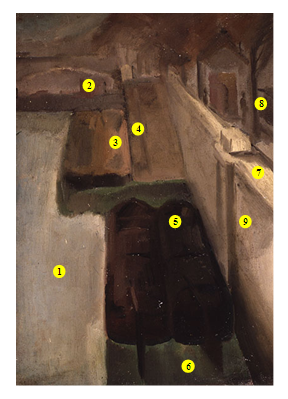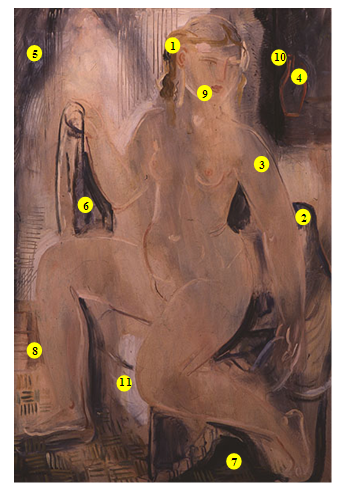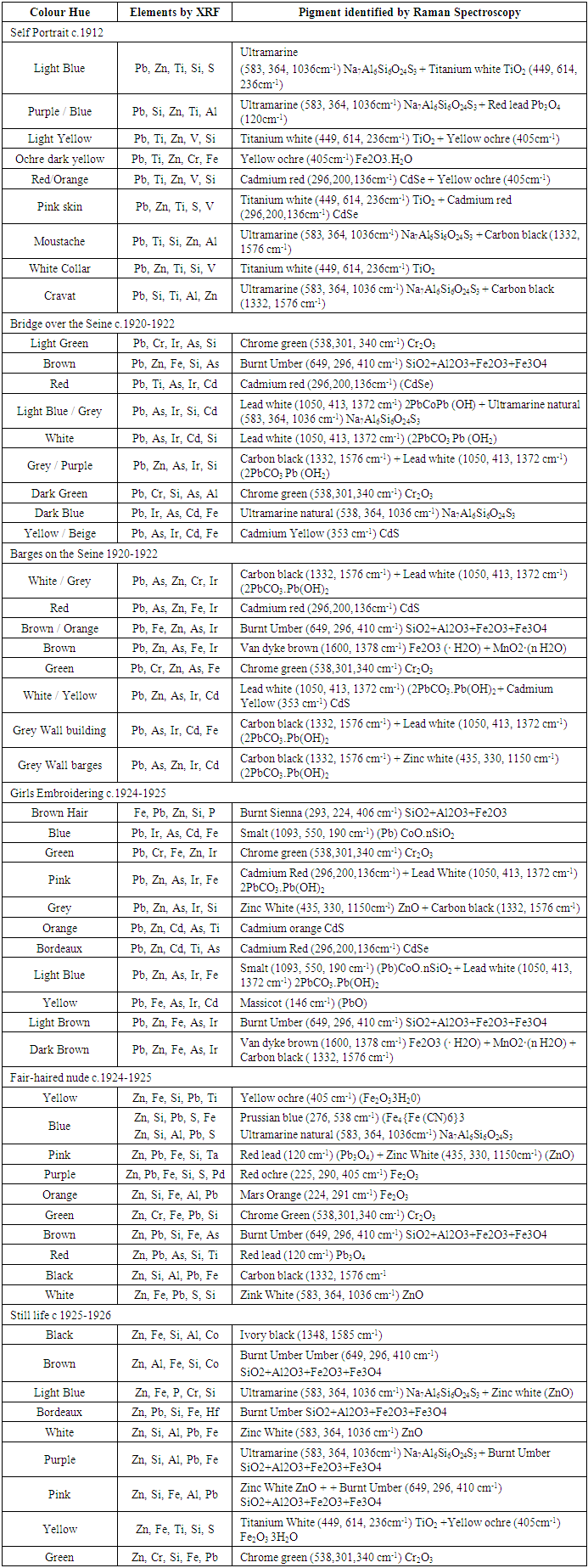-
Paper Information
- Next Paper
- Previous Paper
- Paper Submission
-
Journal Information
- About This Journal
- Editorial Board
- Current Issue
- Archive
- Author Guidelines
- Contact Us
Archaeology
p-ISSN: 2332-838X e-ISSN: 2332-841X
2021; 9(1): 47-53
doi:10.5923/j.archaeology.20210901.09

G. I. Katsigras Museum: In-Situ Measurements in Paintings by G. Gounaro
T. Romantzi1, T. Ganetsos1, D. Giakoumi2
1Non-destructive Research Laboratory, University of West Attica Campus II, Aigaleo, Greece
2Museum G. Gounaropoulos, Ano Ilisia, Greece
Correspondence to: T. Romantzi, Non-destructive Research Laboratory, University of West Attica Campus II, Aigaleo, Greece.
| Email: |  |
Copyright © 2021 The Author(s). Published by Scientific & Academic Publishing.
This work is licensed under the Creative Commons Attribution International License (CC BY).
http://creativecommons.org/licenses/by/4.0/

George Gounaropoulos (1889-1977) was one of the early 20th century artists who introduced modern art in Greece. Following his academic studies at the School of Fine Arts in Athens, he studied and worked in Paris, where in the 1920s he developed his personal artistic style. The Municipal Art Gallery of Larissa, G.I. Katsigras Museum owns ten works by Gounaropoulos. George Katsigras (1914 – 1998) was a doctor and significant art collector who subsequently donated his collection to the Municipality of Larissa. He was a close friend of Gounaropoulos from early on which explains why the Katsigra collection contains some rare examples of the artist’s early and experimental painting. Therefore, we had the opportunity to examine six oil paintings, comprising of a self- portrait from 1912, four works from the early to mid-1920s and one from around 1927-29. The paintings’ study was carried out with the valuable help of new technologies. Two non- destructive methods, XRF and Raman Spectroscopy were used. The combination of those methods gave the most accurate results, capable of creating a database, that could be used to identify other unknown paintings of the artist or to authenticate paintings that do not bear his signature. The research’s main objective is the reconstruction of the artist’s color palette. Moreover, the in-situ study did not affect the paintings’ condition. The needed measurements were easily taken, even without taking the artworks down.
Keywords: XRF Spectroscopy, Raman Spectroscopy, Non Destructive Methods, G. Gounaropoulos, Pigments, Analysis
Cite this paper: T. Romantzi, T. Ganetsos, D. Giakoumi, G. I. Katsigras Museum: In-Situ Measurements in Paintings by G. Gounaro, Archaeology, Vol. 9 No. 1, 2021, pp. 47-53. doi: 10.5923/j.archaeology.20210901.09.
Article Outline
1. Introduction
- In our project we undertake analytical scientific research on works by the eminent Greek modernist painter George Gounaropoulos (1889-1977). Over the last decades, conservation and scientific research have contributed significantly to the better understanding and sometimes de-coding of great works of art by old and modern masters. We believe that some interesting facts will present themselves to us during the course of this research.The G. Gounaropoulos Museum was founded after the artist’s death and following the donation of his house and studio by his late son, Ilias Gounaropoulos to the Municipality of Zographos. The “heart” of the museum is the artist’s house and studio which hosts a permanent collection of over forty artworks.George Gounaropoulos was one of the early 20th century artists who introduced modern art in Greece. Born in a Greek family in the town of Sozopolis on the Black Sea, George Gounaropoulos came to Greece with his parents and siblings in his early teens. His evident talent in painting was the only passport of the financially strained young migrant to the School of Fine Arts in Athens. His artistic training was mainly in the academic style, which was the dominant artistic approach by his professors, all of whom belonged to the so called “School of Munich” and represented the conservative wing of Greek artists. His main teachers were Georgios Roilos and Spyridon Vikatos [1].Following his highly successful studies and after having served in the Second Balkan War and World War I, in 1919 Gounaropoulos left for Paris. Thanks to a grant by a Greek foundation he was able to live in the artistic capital of his time and to study in the best independent art academies, namely l' Académie Julian and l’ Académie de la Grande Chaumière [1]. Under the influence of the modern art movements and with his Greek cultural heritage deeply embedded in his artistic expression, Gounaropoulos developed his own personal artistic style, which evolved through the years and the creation of his oeuvre.At this stage of the project, non-distructive analysis was applied on Gounaropoulos paintings in the collection of the Municipal Art Gallery of Larissa, G.I. Katsigras Museum. George Katsigras (1914 – 1998) was a doctor and significant art collector who subsequently donated his collection to the Municipality of Larissa [2]. He was a close friend of Gounaropoulos from early on which explains why the Katsigra collection contains some rare examples of the artist’s early and experimental painting.
2. Materials and Methodology
2.1. Materials
- A brief outline of the basic characteristics of each one of the paintings that were studied follows.The painting Self Portrait 1912 (oil on board, 27,5x17 cm) is the earliest work by Gounaropoulos that the scientists have been able to examine. Its heavy, dark color palette and the expressive gaze of the sitter are typical of the artist’s academic style, as he mastered it at the School of Fine Arts in Athens [2]. The representation of the artist in a turban, the pose, and the light on the left half of the face are reminiscent of Rembrandt’s Self-portrait at the easel 1660 in the Louvre. Interestingly, a reproduction of this particular Rembrandt self-portrait was always hung next to Gounaropoulos’s study table. Similarly, Gounaropoulos’s self-portrait was always hung next to Katsigra’s desk.
 | Figure 1. Self-Portrait c.1912 |
 | Figure 2. Barges on the Seine c.1920-1922 |
 | Figure 3. Bridge over the Seine c.1920-1922 |
 | Figure 4. Girls Embroidering c. 1924-1925 |
 | Figure 5. Fair - Haired Nude c.1924-1925 |
 | Figure 6. Still Life c.1927-1929 |
2.2. Methodology
- In this study several non-destructive methods were applied, in order to identify the pigments on the artist’s paintings and to reconstruct his color palette, as his work has only been analysed theoretically so far.The analytical techniques used were X-ray Fluoresence along with Raman Spectroscopy and Optical Microscopy, which were performed in-situ. [6]To detect the chemical elements in percentages and in traces the portable Thermoscientific X-MET-8000 Expert XRF analyser was used, equipped with a 50KV mini W-Target X-Ray Tube and a Single Collimatorof 6mm diameter. In order to acquisit the data, a built-in software was used and measurements were saved, as Unicode ASCII file format is compatible for further analysis with specialized software. Due to the nature of research a cross-check calibration was applied with pigments of known XRF spectrum, supplementary to the built-in shutter calibration. [3]. In total 70 measurements were carried out with XRF technique and the colors studied were: Green, blue, yellow, red, pink, brown, black, and white.
 | Figure 7. In-situ XRF experimental work in paintings |
3. Results and Discussion
- In figures 1-6 are shown with yellow dots all the sampling points for each color hue. Following, is presented a table with all summarized results of XRF analysis and pigments identified by Raman spectroscopy. In figures 8 -, representative Raman spectrums for different color along with reference spectrums, are shown. [7].
|
 | Figure 8. Raman spectrum Blue of Self-Portrait identified as Ultramarine |
 | Figure 9. Raman spectrum White of Fair - Haired Nude identified as Zinc White |
 | Figure 10. Raman spectrum brown of Barges on the Seine identified as Burnt umber |
 | Figure 11. Raman spectrum green of Girls Embroidering identified as Chrome green |
4. Conclusions
- The presence study aimed at the pigment identification of six paintings of the well-known artist G. Gounaropoulos at the Municipal Art Gallery of Larissa, in the G.I. Katsigras Museum. Moreover, the reproduction of the artist’s palette has also been the subject of the research.Summarizing the results, G.Gounaropoulos has used in the particular paintings Titanium White, Lead White and Zinc White for white color, Chrome Green for green, Ultramarine, Smalt and Prussian Blue for blue, Burnt Umber, Burnt Sienna and Van dyke Brown for brown, Cadmium Red, Red Ochre and Red Lead for Red color, Cadmium Orange in order to depict orange, Yellow Ochre and Cadmium Yellow for Yellow, Ivory Black and Carbon Black for Black, Grey consisted of Carbon Black and Zinc White, Purple of Ultramarine Natural and Burnt Umber. Finally, Pink was made of either Titanium White and Cadmium Red or Lead White and Cadmium Red or Zinc White and Red Lead.G. Gounaropoulos’ colorful palette can be used to give answers looked for, by art historians and collectors interested in cultural heritage.
ACKNOWLEDGEMENTS
- This research work is a part of PhD Thesis of T.R. The Director of G.I Katsigras Museum I. Deligianni is specially thanked for her permission and generous help during the in-situ experimental measurements.The University of West Attica is also thanked for the funding to this PhD. Without its valuable support this study would not have been conducted.
 Abstract
Abstract Reference
Reference Full-Text PDF
Full-Text PDF Full-text HTML
Full-text HTML